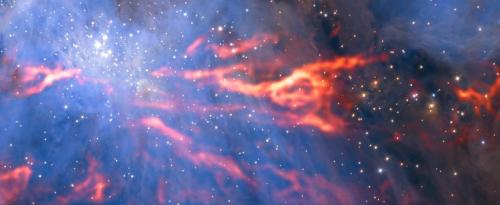ALMA Reveals Inner Web of Stellar Nursery
This spectacular and unusual image shows part of the famous Orion Nebula, a star formation region lying about 1350 light-years from Earth. It combines a mosaic of millimetre-wavelength images from the Atacama Large Millimeter/submillimeter Array (ALMA) and the IRAM 30-metre telescope, shown in red, with a more familiar infrared view from the HAWK-I instrument on ESO’s Very Large Telescope, shown in blue. The group of bright blue-white stars at the upper-left is the Trapezium Cluster — made up of hot young stars that are only a few million years old.

New data from the Atacama Large Millimeter/submillimeter Array (ALMA) and other telescopes have been used to create this stunning image showing a web of filaments in the Orion Nebula. These features appear red-hot and fiery in this dramatic picture, but in reality are so cold that astronomers must use telescopes like ALMA to observe them.
The wispy, fibre-like structures seen in this large image are long filaments of cold gas, only visible to telescopes working in the millimetre wavelength range. They are invisible at both optical and infrared wavelengths, making ALMA one of the only instruments available for astronomers to study them. This gas gives rise to newborn stars — it gradually collapses under the force of its own gravity until it is sufficiently compressed to form a protostar — the precursor to a star.
The scientists who gathered the data from which this image was created were studying these filaments to learn more about their structure and make-up. They used ALMA to look for signatures of diazenylium gas, which makes up part of these structures. Through doing this study, the team managed to identify a network of 55 filaments.
The Orion Nebula is the nearest region of massive star formation to Earth, and is therefore studied in great detail by astronomers seeking to better understand how stars form and evolve in their first few million years.
This image combines a total of 296 separate individual datasets from the ALMA and IRAM telescopes, making it one of the largest high-resolution mosaics of a star formation region produced so far at millimetre wavelengths.
Source: European Southern Observatory
- 370 reads
Human Rights
Ringing FOWPAL’s Peace Bell for the World:Nobel Peace Prize Laureates’ Visions and Actions

Protecting the World’s Cultural Diversity for a Sustainable Future

The Peace Bell Resonates at the 27th Eurasian Economic Summit

Declaration of World Day of the Power of Hope Endorsed by People in 158 Nations

Puppet Show I International Friendship Day 2020

